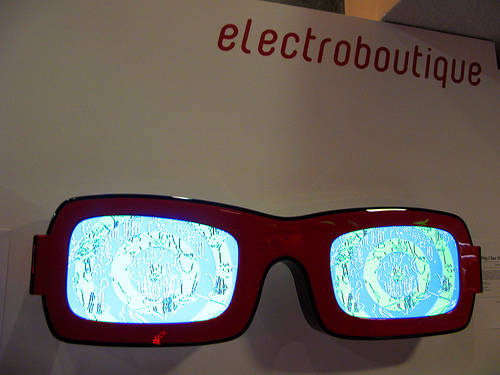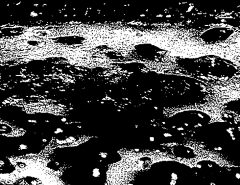En la sede principal de la Transmediale, la House of World Cultures, destacaba un pequeño espacio dedicado a ELECTROBOUTIQUE, que es el nombre de una compañía de producción artística, una galeria y un colectivo rusos, formado por tres artistas: el conocido Alexei Shulgin (de proyectos como la cyberpunk-rock-band 386DX o runme.org, una base de datos online de software art), Aristarkh Chernyshev y Roman Minaev. Con un curioso planteamiento, este colectivo ofrece lo que llaman Media Art 2.0, una serie de dispositivos electrónicos que funcionan a la vez como atractivos objetos market-friendly, destinados a decorar interiores, o como piezas de arte electrónico interactivo dignas de ser mostradas en museos y galerías, a la vez que incorporan discursos críticos, acuñando incluso términos como crititainment (critical + entertaining) para autodefinirse (más abajo su manifesto).
Este espacio tuvo mucho éxito por lo atractivo y espectacular de los objetos expuestos, que invitaban a la interacción y también dieron lugar a hacer un poco el tonto y echarse unas risas, como muestra este video. A los niños también les encantó el asunto (atención al video6).
[PHOTOSET: Electroboutique – Media Art 2.0]
[video1: Commercial Protest]
[video2: Digiluck]
[video3: Personal Art Center]
[video4: The Way I See It]
[video5: Tele Blaster]
[video6: Urgently]
Electroboutique presents new economic model of media art production:
Today, when any critical artistic statement is drained of its power within the rigid frameworks of the unilateral capitalist world, a critical artist can no longer create while contemptuously looking down at commercial art and design that is governed exclusively by market laws.
At the same time as it becomes smarter and more refined, capitalism intrudes into most revolutionary, autonomous, and secluded areas of human activity. This is not to suggest that avant-garde art creation always stood in opposition to capitalism. The modernists, taking part in the evolution of design, worked in factories developing furniture and fabrics in order to bring art to the masses. Parallel to the evolution of Dada, the ready-made, and later, pop art, the theory and philosophy of art and culture contemplated the balance between the poles of capitalism and art, unique and mass-produced objects, high and low culture, professional and amateur, practical and dysfunctional. As the newest weapon of capitalism, information technologies dictate new social and cultural contexts and within these, uncover new challenges.Our answer to the dilemma: Media Art 2.0
Media Art 2.0 goes beyond the limits of new media art
New media art today consists overwhelmingly of one-of-a-kind works presented by the authors themselves at festivals and specialized exhibitions. As a rule, such pieces are high-maintenance and complex in configuration — and thus are destined to remain in a media art ghetto. We propose all-in-one plug-and-play solutions. Media Art 2.0 presents art objects as technological products that are ready to be consumed here and now by anyone.
Media Art 2.0 is market-friendly art
We produce a limited number of copies (like Ferrari) and sell them at affordable prices (like Sony). This is possible because we develop our own reliable electronic devices and thus do not depend on overly complex multi-functional digital systems. Each piece has a unique edition number and the authentic signatures of its authors. We also offer limited lifetime warranties for our products.
Media Art 2.0 goes beyond the know-how of IT corporations
These corporations are not capable of transcending the pragmatism of their products. While attempting to enrich their products with artistic qualities, corporate designers follow the path of banal adornment — decoration with gold, Swarowski crystals, and diamonds — which raises the price and renders the products "exclusive." Such an approach does not make a mobile phone or an MP3 player a work of art. Limited lifetime of electronics contradicts the apparently "eternal" value of the decorative materials.
Media Art 2.0 is the answer to the stagnation of the art market
It proposes a solution when the art market acquiesces to the demands of traditional art forms and is incapable of digesting truly contemporary artistic ideas. Our products harmoniously combine actual art, up-to-date techno-culture, design, and media art. We return to the roots of the avant-garde and occupy our own niche in the system of capitalist production and consumption. We address advanced consumers who are not satisfied by mass products — whether cool design gadgets or the endlessly reproduced traditional art forms.
Media Art 2.0 is the avant-garde of today
We return to art the things that design borrowed from art at the beginning of the 20th century: the search for new form and content; the artistic experiment as play; and the joy of everyday life. We live in a world of visual interfaces. Televisions, print advertisements, politics, shop-windows, show-business, internet services, bank systems are primarily interfaces whose task is to shape the process of information transfer and the translation of ideas. Working with visual interfaces, we make them visible and tangible. We uncover the structures of today’s world. This approach fills our products with a critical charge. In answering the challenges of today, we flush clean the media channels and establish new standards. By infiltrating public spaces and private homes, we bring art and alternative aesthetics into people’s everyday lives.

** The Way I See It




Leave a Reply
Lo siento, debes estar conectado para publicar un comentario.